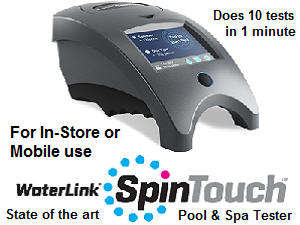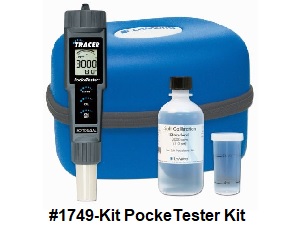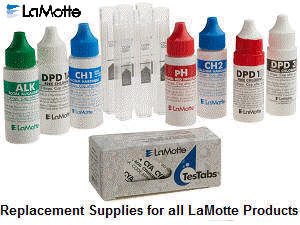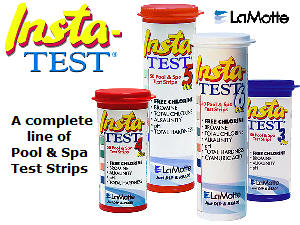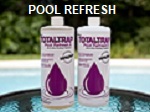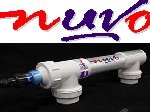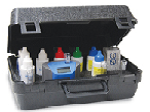| |
|
Scroll
down to browse through some archived SWIMMING POOL
questions and answers. Please click the Pool
Problems Link, on top of every page, to access a
complete listing of Pool Problem subjects, an
alphabetized Website Table of Contents, Pool Equipment
Information, About Alan Biographic Material and a Pool
Glossary. Use the other links to access additional
subject information. More information about some new and
unique products, for pools and spas, can be found by
visiting
The Website
Store. You'll never know what you'll find and
that's always fun. Be better prepared and avoid
costly problems!
|
|
 |
Shipping is FREE* . . . within
the Continental U.S.
A $9.99
handling charge will apply
to Continental U.S. Orders,
under $75.00. Orders
outside of the Continental
U.S. may require some
additional charge, based on
quantity and destination.
Most products can be
shipped World-Wide. International
and orders outside of
Continental U.S. - see
comments on the ordering
pages. |
|
 |

Major
Credit Cards and PayPal are accepted. |
|
On-line
shopping since 2002 - Safe and Secure!!! |
|
Testing Pool and Spa Water Chemistry!!! |
|
Testing
water is an integral part of pool and
spa water management. Reliable and
accurate results are important, in order
to maintain proper water chemistry. The
water balancing or chemistry affects
every aspect of pool and spa management.
A
ColorQ,
All-Digital Water Tester
can perform all of the common pool water
tests, while eliminating the
color-matching and guesswork. There is a
model, for every pool testing need. The
WaterLink
SpinTouch Labs are the
ultimate pool and spa testers, performing
up to 10 different water test factors,
in just 1 minute. They were voted
product of the year. An
Electronic
PockeTester Kit tests for
salt and TDS, as well as other test
factors. Simply Dip and Read. |
|
|
If you have a pool or spa water
testing need, we should have the
product.
►
Scroll down to read through some
Question & Answer information.
◄
|
|
How to control a pool's pH and Total
Alkalinity? |
Proper chemistry starts with the right water tester. A
ColorQ Tester is all-digital and eliminates
all the color-matching and guesswork.
The topics of pH and total alkalinity are
inter-related and are key parameters (factors)
in the overall spa water chemistry. pH is the
relative acidity or alkalinity of the water. The
pH scale goes from 0 (most acidic) to 14 (most
alkaline). A pH of 7.0 is neutral. Ideally, spas
and hot tubs should be maintained in the 7.2-7.8
range for a variety of considerations: sanitizer
effectiveness, bather comfort, corrosion, cloudy
water and scaling. Total alkalinity is a
measurement of the total quantity of alkaline
materials present in the water. Low TA allows
for rapid pH fluctuations, makes pH control more
difficult and can contribute to corrosion. High
TA makes pH adjustments more difficult and can
be a contributing factor in cloudy water and
scaling. A range of 80-120 PPM is considered
optimum. Higher TA readings may not be a
problem, so long as the water is clear, there is
no sign of scaling or discoloration. The
balancing of the overall water chemistry makes
for greater bather comfort, helps avoid problems
and is necessary to assure optimum spa water
quality. If problems arise, refer to the
Pool Problems
Page, as a source of problem-solving
information, broken down into various
categories. Scroll down the page and click on the linked
keywords,
catch phrases
or images, in the archived answers below, to access additional information, on that topic or product.
Do you know what's in your
water? If you're having problems, with sanitation
or water clarity, testing allows you to better understand
the chemistry and determine the cause of the problem.
Once understood, you can select the best treatment option.
Understanding the nature of the problem, should be step
one. For information about our full selection of
testing options, visit our
Test Equipment Store.
 |
Join our E-Letter Mailing List.
You'll receive 1-3 E-Letters a
month, featuring helpful pool
and spa advice, new product
information and sale
announcements. All we
require is your e-mail address
and you can opt out anytime you
wish.
Your information
will never be shared or sold. |
|
▼
Helpful,
Problem-Solving Information, in a question and
answer format.
▼ |
►
TA Adjusted And
Unadjusted Readings?
I use a
Color 2X PRO 7, and the
LaMotte WaterLink HOME Solutions APP, to test my water on a daily basis. What is
the difference between Alkalinity
and Adjusted Alkalinity measurements? Should I use the alkalinity number or the
adjusted alkalinity number, to maintain the correct alkalinity level in my pool?
My current numbers are 142ppm alkalinity and 100ppm adjusted alkalinity with pH
at 7.3ppm. The report indicates my alkalinity is high. Thank you.
Stephen V., 7/14/2022
First let me
make a point, regarding pH and TA. pH is ALWAYS the more important of these two
parameters. It may not be always possible to get both in range, at the same
time. If that is the case and the pH is in range, there is no compelling need to
lower the TA, if it is high, providing that the water is clear and there are no
signs of scaling. Accepting this will spare you the endless raising of the pH,
which results in the TA rising too much. Raising or lowering one always affects
the other, in the same direction.
Traditionally TA is based on bicarbonate-carbonate alkalinity, but other
dissolved salts, such as cyanuric acid, can affect the TA. For this reason
subtracting 30% of the CYA reading, from the TA reading, will give a better
estimate of the bicarbonate-carbonate alkalinity.
Based on the data provided, the difference between the two TA readings can be
accounted for by a CYA reading of about 140 PPM, which you did not provide. In
your case, the available alkalinity is within the typical 80-120 PPM range and
the pH is within 7.2-7.6, as well. Relying on the unadjusted TA, would lead you
to think that an addition of acid, to lower the TA, would be beneficial. The
addition of acid will lower the pH and force you to add soda ash to raise it
back to 7.2-7.6. This will raise the TA and bring you back to the same place you
were, before the acid was added. Avoiding this unnecessary up and down is the
point of what is stated, in the first paragraph. I would rely on the adjusted TA
reading and not add anything to alter the TA. I hope that this is helpful.
Sincerely. Alan Schuster 7/14/2022
►
Low TA - What To Do?
Alan, I just received my
LaMotte ColorQ Test Kit, found
it very easy to use. But now found out alkalinity very low. Is there a way to
get recommendations, on how much chemicals to correct it? Otherwise Iím just
guessing and will probably be all over the place! Thanks in advance for
your time.
Don H., 6/9/2018
TA is a
simple calculation. 1.5 pounds of sodium bicarbonate will raise the TA 10 PPM,
in 10000 gallons, Example: you need to raise it by 40 PPM
and your pool is 18000 gallons - 4 (4, 10 PPM increments) x 1.5
(pounds per 10000 gallons) x 1.8 (size relative to 10000 gallons) =
10.8 pounds of sodium bicarbonate. If you are starting with a low pH, you
might need more. Retest and adjust, as needed. Remember, you can always add more
- you can't take out. This page should help:
Calculating Chemical Additions.
The information is objective and is not designed to maximize your chemical
usage.
Please visit our website Water Testing
Equipment Store to browse through a large selection pool and spa water
testers and replacement items, for all LaMotte testers.
I hope that the information provided was helpful.
Sincerely. Alan Schuster, 6/9/2018
►
pH On The Rise?
I add chlorine manually. I use
liquid bleach or shock treatment packages. Usually just 1 lb to maintain
chlorine residual. I use 2 lbs when I shock. I am under the understanding that
the shock packages have no CYA in it. Since I am already at 50, I do not want to
add anymore CYA. Within the last couple of weeks I have been using liquid
bleach, since I found it is cheaper than the packaged shock. BTW I do have an
ozonator, that helps with the sanitation. Can you use a salt chlorine generator
in a freshwater pool? If so, where is the salt coming from? Thanks.
Dave Y., 8/15/2017

You have to add salt to the water, to use a
salt chlorine generator: about
25 pounds per 1,000 gallons. Not enough to taste and about 1/15th the
level of ocean water. The liquid chlorine and shock both have a high pH
and are the reason the pH is on the rise. The same thing happens with a salt
chlorine generator, as it produces the equivalent of liquid chlorine. There is
no option, so far as adding acid. . A salt chlorine generator works even better,
with a ultraviolet sterilizer
or ozonator
present. You won't have to produce as much chlorine and that will slow the rise
of the pH and help the salt cell last longer. Add a salt chlorine
generator and the pool maintenance and sanitation should become
much easier and more consistent. Add UV or Ozone and the combination works even
better. I hope that this will be helpful.
Sincerely. Alan Schuster 8/15/2017
►
Requiring Frequent Additions Of Acid?
I have
one of the solar salt generators and things are
going great, no more yellow algae. I have a
10,000 gallon in-ground pool with an aggregate
finish. It is about 18 years old and looks good
except for about a dozen black circles where the
finish came off. They vary in diameter from the size
of a dime to a little larger than a silver dollar. I
have to adjust the pH at least weekly and have to
add one to two cups per week. I have been told this
is excessive. My question is, can the black spots,
exposed concrete, be eating up this much acid? I
have looked for the cause on the internet and about
all I can find is "all pools are different, that may
be normal". About 14 years ago I was
using powdered shock and the pool store never said
anything about adjusting pH. Then the store burned
and I went to another local store and started using
liquid chlorine. I needed about a cup or more of
acid to adjust for a gallon of liquid chlorine.
Along the way, it seems I am using more and more
acid. It is still cool in Florida and I shock every
3 - 5 weeks. Even on the weeks I do not add
chlorine, I still need a cup or two of acid to keep
the pH in range. Another thought I had is can
I cover up the exposed concrete without draining the
pool? I know I may not match the color, but I may be
able to make the spots less noticeable. If you think
the missing finish is causing my high acid demand,
is there a product that can be applied under water?
Tony,
Florida, 3/29/2017
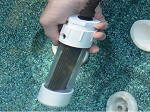
When your were using liquid chlorine, you had to
acid on a regular basis. With a
salt chlorine
generator, you also have to add acid, on a regular
basis. How much acid is related to how much
chlorine is being produced. No matter how or what
you use to chlorinate, the pH has to be monitored
and maintain, in the 7.2-7.8 range. Higher pH
readings will make the chlorine less effective. So
long as the pH is optimized, the additions of acid
will not affect the walls or result in corrosion. I
doubt that a small area of exposed concrete is the
problem. However, you can cover these spots,
without draining the pool.
Boxer Adhesives offers an underwater epoxy, that
cures to a white finish. It would seem like an easy
way to repair the finish. I hope that I have
provided the solution.
Sincerely. Alan Schuster, 3/29/2017
► Battle Of pH and
Total Alkalinity (TA)?
You sent me an email to look over your
revised website. Loved it!
Great! I do have a question though, as always!! Even when I
have my TA between 80 - 120 my pH constantly increases up to
8.0, this happens daily. I try and gradually decrease the pH
by adding acid in a bucket of water each day, but no matter
how carefully I do this my TA always drops. I find it much
easier, in my pool, to keep the TA low, about 40 - 50. My pH
does not bounce around so much and stays at the correct
level of between 7.2 - 7.8. My pool often gets a staining
problem in summer and my local pool shop tells me its
because of the constantly increasing pH levels. I read in
your questions page that low TA can cause corrosion, and am
now worried. I am interested in your opinions and wonder if
I just have an unusual pool. Thanks.
Kelly H., Australia, 11/17/2016
Thanks for the reply. It is more important to maintain a pH
in the 7.2-7.8 range, than it is to maintain a TA of 80-120
PPM. Your water probably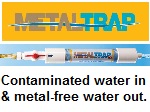 contains some minerals, other than
bicarbonates and carbonates, that cause the buffering effect
to be higher than normal. Try and keep the pH in range. If
you can do this without great difficulty and without daily
corrections and, if the water is clear, there is no reason
to do battle with the TA. The staining could be due to
algae: as the pH rises the chlorine effectiveness decreases
and that, in turn, can lead to a greater likelihood of
algae growth. From your letter it doesn't seem that you are
having pH control problems, so I suggest that you ignore the
TA. The staining could, also, be due to dissolved minerals:
as the pH rises the solubility of many minerals decreases -
another reason to keep the pH in range. Adding a quality,
phosphate-free Mineral Treatment, such as
Liquid
MetalTrap, is always a good idea, if minerals might be
present. Alternatively, you could run all new water through
a MetalTrap Filter. Nothing is
better than preventing metals, from getting into the pool.
I hope this is helpful. contains some minerals, other than
bicarbonates and carbonates, that cause the buffering effect
to be higher than normal. Try and keep the pH in range. If
you can do this without great difficulty and without daily
corrections and, if the water is clear, there is no reason
to do battle with the TA. The staining could be due to
algae: as the pH rises the chlorine effectiveness decreases
and that, in turn, can lead to a greater likelihood of
algae growth. From your letter it doesn't seem that you are
having pH control problems, so I suggest that you ignore the
TA. The staining could, also, be due to dissolved minerals:
as the pH rises the solubility of many minerals decreases -
another reason to keep the pH in range. Adding a quality,
phosphate-free Mineral Treatment, such as
Liquid
MetalTrap, is always a good idea, if minerals might be
present. Alternatively, you could run all new water through
a MetalTrap Filter. Nothing is
better than preventing metals, from getting into the pool.
I hope this is helpful.
Sincerely. Alan Schuster, 11/17/2016
► Color
Vision Problems?
I don't seem to very good at
determining whether the pH color is orangish, orange-red or
reddish. It seems the same with strips or liquids. I may
have a problem discerning colors, but is there a simple
solution?

Adam M., 6/24/2013
Not everyone is adept at seeing small color differences and
certain colors are worse than others. The
ColorQ 2X PRO 7
All-Digital, Water
Analyzer can easily solve your problem. It performs 7
common tests, pH,
free and total chlorine, bromine, total alkalinity, cyanuric
acid and calcium hardness. No colors to match and no charts to look up. It
is reasonably priced and seems to be just what you're
looking for. I hope this will solve the problem.
Sincerely. Alan Schuster, 6/24/2013
► Constantly
Rising pH?
Hi Alan. I have a salt chlorine
generator, in a 20,000 gallon aggregate-finished pool. The
chlorine is a breeze, but I am always adding acid. Is that
normal? What is the best way to handle this? Thank you.
Adam M., Naples, Florida, 8/23/2013
Salt chlorine generators
are very convenient and certainly do an effective job, as
concerns the chlorine level. However, as chlorine is
produced, the pH will rise. Therefore, acid has to be added
on a regular basis. You might need to add acid, a few times
a week, based on chlorine production. Either way, acid has
to be added to keep the pH at 7.2-7.8. Unless the pH is
controlled, it will keep rising and could cause cloudy
water, scaling, loss of sanitizer effectiveness and bather
irritation. You can choose the method, but it has to be
done. I hope that this information is helpful.
Sincerely. Alan Schuster, 8/24/2013
► pH
ad TA
Reassurance?
I have a 22k pool with vinyl liner. It
is now clear with a TA of 140 and a pH of 7.0. I have added
2 lbs then another 2 lbs of pH up with little or no change
in pH. Any help?
Don C., 4/16/2012
pH and TA are interrelated. Raising the pH will raise the
TA. In your case the high TA is making pH adjustment
difficult. However, once it is in range, it will remain
there for longer periods of time. pH is always more
important and you need to raise it to at least 7.2. Adjust
the pH to 7.2-7.8, as needed. There is no compelling reason
to have to lower the TA, once the pH is in range and there
is no sign of scaling or cloudy water. If the calcium
hardness is over 400 PPM, you might keep the pH closer to
7.2-7.4. There's little point in trying to get both
parameters in range, when circumstances and nature are
conspiring against you. Good luck.
Sincerely. Alan Schuster, 4/16/2012
Alan, I did what you said and raised
the pH to 7.3. The TA is now 240. My water is clear and
looks good the Chlorine is 2.0 Calcium hardness is around
200 ppm. I am scared with the high TA, you are the only
person that gives me this advice. My local pool people
demand that TA should not be above 120. I suppose I just
need some reassurance. Thanks.
Don, 4/18/2012
Nothing like being out there on a limb. And did you notice
that I am not trying to sell you chemicals? There is
something called the Langelier Index: a predictor of scaling
or corrosive tendencies of water. Ideally water should fall
within the -0.3 to +0.3 range. Your water calculates out at
+0.2. I agree that lowering the TA could be of benefit.
However, your water is clear, there is no sign of scaling
or cloudy water and Langelier Index is in range and,
therefore, there is no compelling reason to lower the TA.
High TA tends to keep the pH in place for longer periods of
time and, if the pH is optimum, that is a good thing! pH is
always more important. Lowering the TA will lower the pH and
that opens the door to corrosion and irritation problems.
Some might suggest that you add acid to the pool. This will
lower the TA, but it will lower the pH, as well. You might
end up with a "good" TA, but you will have a low pH. The
next step will be to raise the pH. Doing that will raise the
TA. In the end, you'll be out money and have water that is
substantially the same. You'll feel like a yo-yo. A TA
range of 80-120 PPM is accepted as ideal. That means if you
are lower, you should raise it into this range. It doesn't
necessarily mean, that if you are above this range, you have
to lower it, as this depends on other factors. Your TA of
240 PPM is actually lower because you should be subtracting
30% or the cyanuric acid reading form this test value. Ask
the dealer, if he guarantees success and that the chemicals
will be free, if his instructions are followed and both the
pH and TA are not optimized? I suggest that you avoid all
use of calcium hypochlorite products, as this will increase
the Langelier Index. Right now you are OK, so long as the pH
is 7.2-7.5. For shock, use liquid chlorine, non-chlorine
shock or lithium hypochlorite. Do not use dichlor products,
if you are using trichlor, as this will only speed up the
rise of the stabilizer level. You are a good candidate for a
salt chlorine
generator, which can help you avoid buildup issues and
provide more control and better results. I hope that I have helped to
make my case. Let me know how things turn out - either way! problems.
Some might suggest that you add acid to the pool. This will
lower the TA, but it will lower the pH, as well. You might
end up with a "good" TA, but you will have a low pH. The
next step will be to raise the pH. Doing that will raise the
TA. In the end, you'll be out money and have water that is
substantially the same. You'll feel like a yo-yo. A TA
range of 80-120 PPM is accepted as ideal. That means if you
are lower, you should raise it into this range. It doesn't
necessarily mean, that if you are above this range, you have
to lower it, as this depends on other factors. Your TA of
240 PPM is actually lower because you should be subtracting
30% or the cyanuric acid reading form this test value. Ask
the dealer, if he guarantees success and that the chemicals
will be free, if his instructions are followed and both the
pH and TA are not optimized? I suggest that you avoid all
use of calcium hypochlorite products, as this will increase
the Langelier Index. Right now you are OK, so long as the pH
is 7.2-7.5. For shock, use liquid chlorine, non-chlorine
shock or lithium hypochlorite. Do not use dichlor products,
if you are using trichlor, as this will only speed up the
rise of the stabilizer level. You are a good candidate for a
salt chlorine
generator, which can help you avoid buildup issues and
provide more control and better results. I hope that I have helped to
make my case. Let me know how things turn out - either way!
Sincerely. Alan Schuster, 4/19/2009
► Using
Sodium TetraBorate?
I just can't get my pH and total
alkalinity on the same page. Either both are too high or the
pH is too low. It doesn't make sense to add acid and then
add soda ash. Have a suggestion?
Jeff H., 7/2/2010
Sometimes, Nature conspires against proper pool chemistry,
by having minerals present in the water. pH is always more
important and you should get it into the 7.2-7.6 range. If
the TA is too high, it might not be a problem, so long as
the hardness is not over 400 PPM, the water is clear and
there are no signs of scaling. Otherwise, you might try
adding acid and dropping the TA to about 100 PPM. Your pH
might be too low, at this point. Instead of using soda ash to
raise the pH, use sodium tetraborate. It will still raise
the pH, but will not contribute to the bicarbonate-carbonate
content, which is the basis of the TA test. I hope that this
information is helpful.
Sincerely. Alan Schuster, 7/3/2010
► pH
and Total
Alkalinity Challenged?
Good morning. I am so confused, I have
an above ground pool, 10,000 gallons, pool looked real clear
and clean, my pH was low and for some unknown reason to me,
I could not get the pH up to par. So I took a water sample
to the nearest pool supply store. I was told that my total
alkalinity was 250 PPM and the pH was 6.8 and I must get the
TA between 125-150 PPM, before trying to balance the pH. I
added dry acid and got the TA to 140 PPM. I have now added a
total of 5 pounds of pH increaser and it is still low and my
pool is cloudy now. What major effect does alkalinity have
on the pool and it really necessary to keep it between
125-150 PPM, if the pH and chlorine are balanced? Do you
have any idea what is wrong and how I can correct this
problem? Is it OK to shock the pool while I am trying to
raise the pH? It show I have 1.5 PPM chlorine in the pool,
but I have not shocked it for a while and I think that I may
need to. Thank you.
Clifford P., 9/17/2018
I'll bet that you are feeling like a yoyo? THERE IS NO
COMPELLING REASON TO HAVE TO KEEP THE TA BETWEEN 125-150
PPM, IF THE pH IS CORRECT, THE WATER IS CLEAR AND THERE ARE
NO SIGNS OF CALCIUM SCALE FORMATION! Adding the acid
lowered the TA and lowered the pH. Adding the pH increaser
raised the pH and the TA. You accomplished very little. I
suggest that you add pH increaser and raise the pH to
7.2-7.6. If at this point, the water is clear and there are
no signs of scale formation, leave the TA alone. The higher
TA will help stabilize the pH for even longer periods of
time. The only time a high TA will cause a problem is if the
calcium hardness level is too high. A calcium hardness level
over 400 PPM, might require you to lower the pH to 7.2-7.4.
You can add shock at any time. Bear in mind that shock
products can affect the pH, depending upon which product is
used. I hope that this information will prove helpful. Let
me know how it turns out for you.
Sincerely. Alan Schuster, 9/17/2018
► Not Playing
YoYo?
Thank you for your reply to my
question. I have now resolved the problem first by several
partial drainings, which reduced the alkalinity from the 200
range to just above 100. Then I discovered that I could use
sodium tetra borate to raise the pH. This actually does
raise pH significantly, BUT has very little effect on
alkalinity. Using acid to take both readings way down and
then introducing the sodium tetraborate brought the levels
to where I wanted them.
John D., 8/24/2007
At least you were not playing yoyo with the pH and TA. The
partial drainings lowered the cyanuric acid and, possibly,
the hardness level. These contribute directly or indirectly
to the TA reading. Unless these parameters were high, you
might have accomplished the same effect without the
draining. Using sodium tetraborate will raise the pH and not
contribute as to the bicarbonate-carbonate alkalinity. To
get a truer fix on the TA, subtract 30% of the cyanuric acid
reading from the TA reading. I am glad that I have been
helpful in solving the problem.
Sincerely. Alan Schuster, 8/25/2007
► pH Rising
After Cleaning And Refilling?
A few weeks ago I emptied, cleaned and refilled the pool.
Since then I have problems maintaining a ph between 7.2 and
7.6 . ph increases constantly Ė when I adjust it to 7.0 with
muriatic acid then increases it to 8.0 within one week. And
this constantly from week to week TA is 60, ph is ~ 2.5,
cyanuric acid is ~ 25. What do I need to do in order not to
have to constantly adjust pH? Thank you and best regards.
Harold M., Arlington, TX 11/7/2011
It would have been helpful to know the calcium hardness. I
am going to assume that this is a gunite pool. If hat is the
case, and the water used to fill the pool was low in calcium
hardness, the pH is rising because calcium is leaching from
the walls. This will raise the pH, as the walls slowly etch.
By raising the calcium hardness to 200-250 PPM, you will
stop the etching and the pH should be much easier to
control. I hope that this information will be helpful.
Sincerely. Alan Schuster, 11/7/2011
► High TA And
Green Water?
Hi, Alan. We just opened our pool and
added fresh city water a few days ago. Our total alkalinity
is off the charts Ė around 400. I keep reading conflicting
instructions on how much Muriatic Acid to add and how often.
One website said not to add more that 1 Qt per 10,000
gallons in a 24 hour time period. (Our pool is about
16,000). Another website said to add 3 gallons to get it
down to the optimal range, but didnít say how much to add
and how often. So far, weíve added about 1.5 gallons at a
slow pace for the last 2 days, but itís still 400! The pH
is registering about 7.0 right now. Also, can we add
chlorine? We havenít added any yet and there is no free
chlorine left from the winter. (The pool is green). If itís
OK to add chlorine, should we use shock or liquid chlorine?
Kari B., 4/16/2009
A TA of 400 is too high. However, a pH of 7.0 is borderline
low. You have green water and algae and that is the first
step that you need to take. When you solve that problem, you
should address the TA and the pH. By all means use liquid
chlorine. It will raise the pH slightly and may be all that
is needed to correct that parameter. Once the algae is gone,
add a dose of a blue clarifier to help remove dead algae and
debris. Adjust the pH to 7.2-7.6. If the water is clear and
there is no sign of scaling (due to high calcium hardness
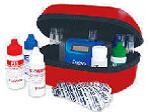 levels), there is no compelling reason for you to have to
reduce the TA. NONE! That is unless you want to add acid, only
to have to add pH increaser soon after. It is not always
possible to get them both in balance and pH is always more
important! My advice on high TA has always been to add one
pint of acid daily, until the TA is in range or the pH
reaches a low of 7.2 and at that point -- stop! I am not
saying that TA is unimportant. A high TA will require more
chemicals to adjust the pH. However, if the pH is optimum, a
high TA will keep it there for longer periods of time and
that is a good thing. If the water is clear, there is no
need to keep adding acid and ending up with a low pH and
having to boost it up. I suggest that you test the calcium
hardness. With a higher TA, you want the level to be not
higher than 200 PPM, in order to avoid scaling. If your
calcium hardness is above 200 PPM, you might want to lower
the TA over time, as I have suggested it be done. I suggest
that you refrain from using chlorine or shock containing
calcium hypochlorite. I seriously doubt that you have a pH
of 7.0 and a TA over 400 PPM. It would be a tall order
to create that condition, in a pool. Make sure that the
tester is in agreement, with the local pool store. A
ColorQ
all-digital tester might be something to consider, as it
eliminates all the color-matching and guesswork. I hope that you will find the
information helpful. levels), there is no compelling reason for you to have to
reduce the TA. NONE! That is unless you want to add acid, only
to have to add pH increaser soon after. It is not always
possible to get them both in balance and pH is always more
important! My advice on high TA has always been to add one
pint of acid daily, until the TA is in range or the pH
reaches a low of 7.2 and at that point -- stop! I am not
saying that TA is unimportant. A high TA will require more
chemicals to adjust the pH. However, if the pH is optimum, a
high TA will keep it there for longer periods of time and
that is a good thing. If the water is clear, there is no
need to keep adding acid and ending up with a low pH and
having to boost it up. I suggest that you test the calcium
hardness. With a higher TA, you want the level to be not
higher than 200 PPM, in order to avoid scaling. If your
calcium hardness is above 200 PPM, you might want to lower
the TA over time, as I have suggested it be done. I suggest
that you refrain from using chlorine or shock containing
calcium hypochlorite. I seriously doubt that you have a pH
of 7.0 and a TA over 400 PPM. It would be a tall order
to create that condition, in a pool. Make sure that the
tester is in agreement, with the local pool store. A
ColorQ
all-digital tester might be something to consider, as it
eliminates all the color-matching and guesswork. I hope that you will find the
information helpful.
Sincerely. Alan Schuster, 4/16/2009
► How Much
Acid Is Too Much?
When our pool gets out of balance, my
husband thinks it must be solved in one day and puts in up
to 3/4 gallon acid in one day. My pool repair people think
this is excessive. How much acid is too much to be good for
people and pool?
Catherine, 4/16/2011
The important consideration is, what is the pH? Even if I
knew how big your pool is, I could not answer the question.
If you add acid and end up with a pH below 7.2, the amount
was excessive. If the pH ends up at 7.2-7.8, it was a
reasonably correct amount. If the pH remains high, more needs to be
added. Acid will react with alkaline materials in the pool
water and only the pH reading determines, if too much has
been added. If your pool is being maintained on liquid
chlorine, depending upon how much chlorine is added weekly,
a certain amount of acid will probably be required. The
amount depends upon your pool size, circumstances and water
chemistry. A word of advice. You can always add more - you
can't take out! I hope that I have been helpful.
Sincerely. Alan Schuster, 4/17/2011
► Worried
About Adding Too Much Acid?
I've added what I think is too much
Muriatic acid in my salt water pool. My test asked for 1
quart for my 20,000 gallon pool and I put 2.5 quarts. Should
I be concerned? and do I need to drain my pool? Thank you
for your time.
Jessica, 9/29/2006
Unless your pH has dropped below 7.2, you have not added too
much acid. You add acid to lower the pH. If too much is
added (the pH is under 7.2), all you need to do is add some
soda ash to raise the pH into the 7.2-7.6 range.
Salt
chlorine generators tend to cause the pH to rise over time,
so adding acid will become a regular occurrence, as will the
testing of the pH and chlorine. Monitoring the
salt test
level is important, as it directly affects chlorine
production and the life of the salt cell. I hope that I
have put your mind at ease.
Sincerely. Alan Schuster, 9/29/2006
► Is The High
TA Causing Problems?
Alan. Nice informative website. I
think I've read most of the information you have given
regarding high TA and not to worry if the pH is okay and I
don't have a problem with cloudiness. However, our water
calcium hardness is high to start (city water) and I have
noticed shades of grey forming, starting at the bottom of
the deep end and a little here and there around the pool.
Based on what I have read and been told, scale formation.
Depressing, since I'd just had the pool resurfaced last
year. My question would be to confirm that I need to lower
the TA and if there's anything I can do to get rid of the
grey shades. Also lowering the TA will lower the pH, do I
simply lower the TA regardless of how low the pH becomes and
then raise the pH after? Thanks.
Rich L., 3/3/2007
The shades of gray could be scale or it could be a mineral
problem. Have the calcium hardness level checked. Testing
for iron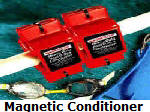 and copper is suggested. If, the calcium hardness
is less than 400 PPM, scale formation is either unlikely or
easily corrected by lowering the pH and/or the TA. High TA
is a problem, if it leads to scale formation. You can do
several things: drop the pH into the acid ranges, add a
calcium sequestering treatment and slowly restore the pH or
add acid and drop the pH to 7.2, add a scale control
agent and keep the pH at this low point until the deposits
are gone. If your pH should get too low, use sodium
tetraborate to raise the pH, as it will do
without adding
to the biocarbonate0carbonate alkalinity. Your city water may be hard, but it still may not
be excessively high in calcium. In either case, I would
refrain from all use of calcium hypochlorite products, as it
can only add to the problem. The addition of a
Magnetic Water Conditioner
might help you avoid some of the scaling issues. I hope that this information
will prove helpful. and copper is suggested. If, the calcium hardness
is less than 400 PPM, scale formation is either unlikely or
easily corrected by lowering the pH and/or the TA. High TA
is a problem, if it leads to scale formation. You can do
several things: drop the pH into the acid ranges, add a
calcium sequestering treatment and slowly restore the pH or
add acid and drop the pH to 7.2, add a scale control
agent and keep the pH at this low point until the deposits
are gone. If your pH should get too low, use sodium
tetraborate to raise the pH, as it will do
without adding
to the biocarbonate0carbonate alkalinity. Your city water may be hard, but it still may not
be excessively high in calcium. In either case, I would
refrain from all use of calcium hypochlorite products, as it
can only add to the problem. The addition of a
Magnetic Water Conditioner
might help you avoid some of the scaling issues. I hope that this information
will prove helpful.
Sincerely. Alan Schuster, 3/3/2007
► Low pH and
High TA?
I know that the pH and alkalinity are
generally linked to each other - in that if the TA is high
then the pH usually follows. But, I am wondering why
sometimes the pH is low and the TA can be high (like a pH
6.8 and a TA at 180 PPM). Have you had any experience on how
this phenomenon occurs? And also - the best way to remedy
the situation. Thanks very much.
Kent K., 6/27/2006
When you have a situation as you are describing it is likely
because the total alkalinity is not being based solely on
the typical bicarbonate-carbonate buffering system. Cyanuric
acid and other naturally occurring minerals can produce an
alkalinity reading without necessarily stabilizing the pH in
the optimum range. pH is always the more important
parameter. If the water is clear and there are no signs of
scaling, there is no compelling reason to have to maintain a
TA in the 80-120 PPM. Adjust the pH to optimum. If the TA is
too high (as expected in this case) and the water is clear
and there is no scaling present, all that the high TA will
do is to help stabilize the pH even more than usual. And
that is not a bad thing! Trying to balance both parameters,
in every pool, will likely lead to frustration and
credibility gaps, in many instances. I hope that I have
provided some good advice.
Sincerely. Alan Schuster, 6/27/2006
Thanks very much, Alan. Working in the
profession myself, I can say I both appreciate and respect
your knowledge and pool maintenance tips. Good to hear your
advice. Best regards.
Kent K., 6/27/2006
► Low pH
Causes Burning Eyes?
We have a "L" shaped pool 40X20X16.
The water was crystal clear, steps and skimmers were pure as
white. I took a water sample to pool supply place and they
said there was no Alkalinity in the water and the pH was
very low. Told me to purchase 45lbs of Alkalinity increaser
and 10 lbs of pH Increaser. Put to Alkalinity in about 6
hours prior to the pH increaser. Alkalinity went to 155, pH
6.2. They told me to add 5 lbs more or pH increaser. The
steps are "BROWN"! and so is the skimmers. And the water is
cloudy. As soon an I add a little Muriatic Acid, the steps
turn white again instantly! Should I believe the tester of
my water or my eyes. It seems to me I should have left the
water alone, except when I was vacuuming it a couple of
weeks ago, I had an itch in my eye and I think I got a
little pool water on my hand then I rubbed my eye. It burned
my eye for more than 5 hours after that. I almost went to
the Emergency room. What do you think is my problem?
Bob G., 6/16/2008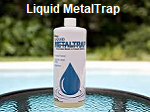
Of course you believe your eyes. They're burning because the
pH is too low. A low pH reading makes the chlorine more
irritating and aggressive. It also tends to keep minerals in
solution. The brown stains are probably iron and other
minerals that precipitated, as the pH was raised. You have
no choice about raising the pH. I suggest that you have the
water tested for iron. Get the steps white and then add 1-2
doses of a quality, phosphate-free, mineral treatment, such
as Liquid METALTRAP, before you attempt to raise the pH.
Allow about 6 hours of circulation before attempting to
restore the pH. Add pH Increaser only. TA increaser is
probably not going to be required. Do not swim with the pH
at low levels. Good luck and I hope that I have been
helpful.
Sincerely. Alan Schuster, 6/16/2008
► What To Do
About High TA?
Alan, my inground pool is less than 4
months old. Construction is concrete with white marcite
plaster finish. I use auto controllers and a UV light system
for better water conditions. I have recently run into a
problem with pH and alkalinity. This particular pool is 30 x
50 and indoors with a dehumidification system to ensure
proper indoor pool climate. When I perform daily/hourly pH
and alkalinity tests, the controller is 7.5 pH, my pH water
test is 7.5. This is good. However, when I perform the
alkalinity test, I get readings that are 50 to 80 points
per/million too high. If I add acid to lower the TA, then my
pH drops and then end up adding dense soda ash or sodium
bicarbonate to increase pH. I use liquid chlorine (sodium
hypochlorite) for sanitation, and I know it adds alkalinity.
How do I get my pH / TA back in balance?
Perplexed, 9/30/2006
Not one word in your letter about cloudy water. That leads
me to believe that your water is clear and there are no
other problems with the pool water. That being the case,
there is absolutely no reason to have to lower the TA.
Adjust the pH to optimum and if the TA is too high, leave it
be! Unless you are having cloudy water or calcium scale
problems, the higher TA will cause no problems. Lowering it
will prove elusive and accomplish little. If in the future,
if there are cloudy water conditions or calcium scaling, the
problem can be addressed. In the meantime, the higher TA
will act to better stabilize the pH. I hope the advice will
help.
Sincerely. Alan Schuster, 9/30/2006
► Bicarbonate Or
Soda Ash?
I would like to know the difference
between soda ash and sodium bicarbonate? I have been using
sodium bicarbonate for raising pH. Do I also need to add
soda ash to raise Alkalinity?
Jeff C., 4/27/2007
Rule #1: pH is always more important the TA. Always! You
seem to have gotten things backwards. Sodium bicarbonate
(baking soda) should only be used to raise the TA, as it has
only a slight effect on the pH. Sodium carbonate (soda ash)
is only used to raise the pH, as it is much more effective
than sodium bicarbonate. Soda ash will also raise the TA, to
an extent. If you use soda ash to raise the TA, you will
probably end up with much too high a pH. I hope that this
information is helpful.
Sincerely. Alan Schuster, 4/27/2007
► Too Much
Total Alkalinity (TA)?
My total alkalinity is usually over
180 PPM. My pH is good and the water looks great. My problem
is that every time I try and lower the total alkalinity to
below 120 PPM, I end up with a pH that is too low. Raising
the pH back up, ends up raising the total alkalinity. I feel
as if I'm being yo yo'ed. Any suggestions?
Steve T., San Antonio, TX, 7/23/2006
It is more important to maintain a proper pH, than it is to
maintain a TA of 80-120 PPM. Minerals that may occur
naturally, in your water, might be contributing to this
phenomenon. There is no compelling reason for you to have to
lower the TA: your pH is good and the water is clear. Stop
worrying about the TA, unless there are signs of cloudiness,
the appearance of calcium scale or other water chemistry
problems. Leave the worrying to those with very low TA, that
are unable to keep the pH from bouncing. Enjoy the summer.
Sincerely. Alan Schuster, 7/23/2006
► High Total
Alkalinity?
I refilled my spa last week and I just
had my water tested and the results follow: pH 7.4, TA 155,
calcium hardness 178, bromine 3.5 PPM. The water looks
perfect. The dealer suggested that I add some Total
Alkalinity Decreaser. Should I add the product? I'm not sure
that it's necessary. Please let me know what to do. Thanks.
J. N., Albany, GA, 5/30/2005
Your TA is marginally above the ideal of 80-120 PPM.
However, your pH is ideal. the calcium hardness is very good
and the water is "perfect." A higher TA means that your pH
will remain in place for even longer periods of time and,
with a pH of 7.4, and that is a good thing! In your
particular case there is absolutely no reason to adjust the
TA. It would be different, if your calcium hardness was too
low, or the pH was too high or if the water was not
"perfect." I hope that I've made the point. Enjoy the spa.
Sincerely. Alan Schuster, 5/30/2005
► Acid Demand
Test?
Hello, when I am doing an acid demand
test, what product am I adding when it is out of balance?
Thanks.
Darryl, 4/3/2012
An acid demand test is performed, when the pH is too high,
in order to determine how much pH reducer (sodium bisulfate)
is required. The results are probably in pounds per 10,000
gallons of pool water. Remember, you can always add more -
you can't take out! Hope I've been helpful.
Sincerely. Alan Schuster, 4/3/2012
► Too Little
Total Alkalinity (TA)?
Can I use pH increaser to raise my
total alkalinity? My readings are around 50 PPM and the pH
of the water is 6.9. Needing some help.
Jim I., Jamesport, NY, 7/6/2004
No, you should not use pH increasers to raise the TA. To do
so could raise the pH too high and that will require more
adjustment in the opposite direction. Raise the TA, using a
Total Alkalinity increaser (sodium bicarbonate) and then test the pH. If too low,
add some pH increaser. In all likelihood, adjusting the TA
will correct the pH and bring it into the ideal range. Enjoy
the season.
Sincerely. Alan Schuster, 7/6/2004
► Low TA and
Proper pH?
Since
you are a professional in the field I have to ask you this
question. I know there are some questions posted about low
total alkalinity and pH. I am an inspector for swimming
pools, and know the consequences of high and low alkalinity.
The total alkalinity is 40-50 (for the past few months), but
perfect pH (7.2) and FAC (>0.5 ppm). In our regulation it
states that the total alkalinity must be at least 80 ppm.
The operator said he always adds sodium bicarbonate to raise
the total alkalinity but it always lowers to the present
values. You said it might be do to mineral content. In your
professional opinion should he try adjusting the tot
alkalinity (which it will always lower) or keep it the way
it is. Thanks for any feedback.
Troy S., 4/28/2005
The pH is at the lower limit. The low TA makes it easier for
the pH to fluctuate and that is not desirable. All that
should be necessary is for the TA to be raised with sodium
bicarbonate. As it is added, the pH will rise slightly. Keep
adding the bicarbonate, until the TA reaches 80 or the pH
reaches 7.6. At that point stop. The type of chlorine that
is being used may account for the lowering of the TA and the
pH of 7.2. I hope that I have been helpful.
Sincerely. Alan Schuster, 4/28/2005
► High Total
Alkalinity?
The info on how the alkalinity reading
is impacted by the cyanuric acid in the pool was very
helpful and as I understand the formula, one should subtract
a third of the cyanuric level from the total alkalinity
reading. Is this correct? The question I have is about my
testing of alkalinity. I followed the instructions and find
that my reading is 170. I had had my water tested at my pool
supply store and the computer says that my reading is 89
after the cyanuric level is considered. My cyanuric level is
70. This is a bit high however I live in Houston, TX and I
understand the heat levels require a higher cyanuric level.
Any idea why I get such a high reading when I test? I drop
the acid demand in slowly and swirl the water between each
drop and wait for the water to chance from blue to clear as
I count each drop. My water hardness is 280. Thank you for
any advice you can offer.
T.C., Houston, TX, 4/7/2008

If your cyanuric acid level is 70 PPM, it is quite
appropriate for your situation. This would contribute 20-25
PPM to the total alkalinity reading. Your TA reading of 170
PPM and the store's net reading of 89 PPM do not agree. One
of them is wrong! If your calcium hardness is 280 PPM, it is
likely that the TA is not as low as 79 PPM. All I can
suggest is that you verify the test results with another
water sample or get a more reliable tester or both. Of all
the common tests, cyanuric acid can be the least
reproducible. An
all-digital
ColorQ PRO 7 Water Tester will provide you with reliable
results and eliminate the color-matching and guesswork. I hope that I have been helpful.
Sincerely. Alan Schuster, 4/7/2008
► Dealer
Suggested Maintaining A Lower pH?
What a great site, it has already
given me a lot of help. Last summer when I took a water
sample in to the pool shop I though the pH was fine but I
was advised to lower it. All summer they told me to keep the
pH a bit lower than the usual 7.2. I never got a full
explanation, as to why, but they seemed to say it was
because of the extreme heat in the Australian summer. Do you
know of any reason why pH should ever be kept slightly below
the normal recommenced range. At present I have it is in the
normal range and it looks fine.
Chris, Australia, 1/15/2009
If your TA and/or hardness were high, lowering the pH could
help assure that the calcium does not precipitate or cause
scaling. Most manufacturers that utilize copper ionization,
as part of the sanitizing method, prefer a slightly low pH.
However, low pH readings below 7.0 can cause corrosion of
the copper in the heater and will make chlorine more
irritating, but it will make the chlorine more effective.
The high summer temps might have prompted the
recommendation. You might ask the dealer, for the reason, as
I do not have all the facts, of your situation. I hope that
this will prove helpful.
Sincerely. Alan Schuster, 1/16/2006
► Why Not A
Low pH?
If chlorine works better at lower pH
readings, why not keep the pH lower than 7.2-7.8?
Anonymous, 6/2/2004
Chlorine does work better at a pH below 7.2. However, there
are consequences that will result. Corrosion can present a
problem below 7.0. As the pH falls below 7.2, chlorine can
become increasingly more aggressive and irritating. The pH
of the eye fluid is 7.6 and, as you move further away,
discomfort can increase. I hope that I have answered the
question.
Sincerely. Alan Schuster, 6/2/2004
► Muriatic
Acid Or Sulfuric Acid?
What are the advantages/disadvantages
of muriatic vs. sulfuric acid for pH balance in pools. These
pools have salt based chlorination systems. Thanks. Regards.
Pat T., Tucson, AZ, 2/12/2010
Sulfuric acid has nearly 3 times the pH neutralizing power
of muriatic (hydrochloric acid). It lowers the TA, more
aggressively, than muriatic acid, but the pH will drop as
well. However, it is far more dangerous to handle and, in my
opinion, should not be offered for use in swimming pools. So
far as the salt chlorination system is concerned, there is
no advantage or disadvantage. Did you know that, if you add
sulfuric acid to an equal amount of water, the temperature
of the solution rises to above the boiling point of water?
Stick with the muriatic acid or sodium bisulfate (granular
pH reducer), as there is no compelling reason to have to use
sulfuric acid. There is a way to make pH control easier, by
using an automatic pH Controller. It adds acid, as needed,
to maintain the pH within a preset range. I hope that
you'll find the advice worth following.
Sincerely. Alan Schuster, 2/12/2010
Thanks Alan. The reason I am asking is
I have installed several acid dispensing systems, using
metering pumps, for my neighbors recently. One of them has
been using sulfuric acid rather than muriatic. I bought
muriatic for him and want to explain the differences to him.
Three of us have salt based chlorination systems in my
neighborhood and all require constant acid-about two cups
per day for a 15,000 gal pool. They also require about 5
pounds of sodium bicarbonate weekly to keep the total
alkalinity at about 110. The pools are all over a year old
and are made of an aggregate finish, which is common in our
area. I wonder if our acid usage will decline, if we forget
about total alkalinity and just let that go where it may and
just keep the pH at the correct level. Do you have any
experience with salt based chlorination systems requiring
chemicals like this? We live in Tucson, AZ. Thanks. Alan,
your insight is always very helpful. Regards.

Pat T., Tucson, AZ., 2/13/2010
I directed the question to a leading manufacturer of
salt
chlorinating systems. The recommendation is to use muriatic
acid. Sulfuric acid is not something that is safe to handle.
Muriatic acid may not be pleasant, but it is far safer. Good
luck and I hope that I have been helpful.
Sincerely. Alan Schuster, 2/13/2010
► Dry Acid Or
Muriatic Acid?
If I were to use a liquid acid
(instead of dry acid) to reduce pH, is there a difference
between using muriatic and dry acid? I seem to recall
reading something that pool dry acid would be less likely to
reduce TA as much as muriatic. Is that true?
Martin, 4/4/2007
The two chemicals have exactly the same effect on pH and TA,
when you allow for differences in their form. Three pounds
of the dry acid (sodium bisulfate) has about the same pH
lowering and TA lowering strength as one-liter (just over
1-quart) of muriatic acid (hydrochloric acid). The dry acid
probably costs more, but is easier to handle, less apt to
spill and lacks the noxious fumes of the liquid acid. I hope
that this clarifies the issue.
Sincerely. Alan Schuster, 4/4/2007
► Using
Carbon Dioxide To Lower pH?
Iím new to pools, but as purchasing
coordinator for a retirement community, I am getting
involved. I am told that CO2
can be used as an effective pH reducer. My question is how
does CO2
react to cause this drop in pH. Any information you can
afford would be greatly appreciated.
Bill K., Lincolnshire, IL, 4/4/2009
Carbon dioxide or CO2
dissolves in water forming carbonic acid. It is a weak acid
and will lower the pH. It is not simply added to the pool.
It will require special feeders and may not be very cost
effective or efficient. It's main advantage is probably the
safety issue. Most pools of your type rely on muriatic acid
for pH reduction, which can be used with a pH Controller or
metering system and is very cost effective. In either case,
at any given pH the water is indistinguishable. I hope that
I have been of assistance.
Sincerely. Alan Schuster, 4/4/2009
► Low TA And
A Good pH?
Recently, I refilled an above ground
pool (approx 12000 gallons) after a liner replacement. I had
the water tested and was told that everything is OK, except
for the total alkalinity, which is a little low at 60. If
that is the case, do I have to raise the alkalinity to 100,
as suggested. Thank you.
Fred R., Nashua, NH, 7/12/2008
It is not etched in stone that you have to raise the Total
Alkalinity. However, a better question would be "should you
raise the TA" and the answer is YES. The purpose of keeping
your TA, around 100 PPM, is to help stabilize the pH and
avoid rapid changes in pH, as routine maintenance chemicals
are added. Ultimately, the higher TA should make the pool
water chemistry easier to maintain. About 6-7 pounds of
total alkalinity increaser chemical would be required, to
raise your pool from 60 PPM to 100 PPM. I'm a believer in
correcting low TA. It's your choice. Have a good season.
Sincerely. Alan Schuster, 7/13/2008
► Conflicting
Results?
Dear Alan, I really like your website.
I do have a question on test strips and alkalinity. Can
something in the water make alkalinity not read on a test
strip? I am in the pool business and I have this pool that
when I use a test strip to test alkalinity it comes up in
the 0-40 category. I know this is inaccurate because I added
bicarb to the swimming pool and got a 100 reading with test
drops. Any information you can supply me with will be a
pleasure. Thank You.
Kevin, 5/30/2007
It's nothing as mysterious as something in the water. One of
the testers is not functioning properly or is being misused.
Double check the directions. Based on the fact that you
added something to raise the TA, I would suspect that the
test strips are not read ing properly. The most likely cause
is excessive heat or exposure to moisture (wet fingers) or
chemicals. It is bad technique to remove a test strip with
wet fingers. Have you tried another package of test strips?
The product, based on my own experience is suitably accurate
and has good shelf-life. You need to verify the test result,
by using different test materials or chemicals. I'm sure
that you'll find the culprit. If you would like to consider
a step up in water testing, the
ColorQ PRO 7 Water Analyzer,
would be an ideal solution. It is all digital, requires no
color matching, eliminates all guesswork or look up charts.
I hope that this information is helpful. ing properly. The most likely cause
is excessive heat or exposure to moisture (wet fingers) or
chemicals. It is bad technique to remove a test strip with
wet fingers. Have you tried another package of test strips?
The product, based on my own experience is suitably accurate
and has good shelf-life. You need to verify the test result,
by using different test materials or chemicals. I'm sure
that you'll find the culprit. If you would like to consider
a step up in water testing, the
ColorQ PRO 7 Water Analyzer,
would be an ideal solution. It is all digital, requires no
color matching, eliminates all guesswork or look up charts.
I hope that this information is helpful.
Sincerely. Alan Schuster, 5/30/2007
► Salt
Chlorinator and High pH?
Thanks so much for your web site! We
installed a Salt Chlorinator about 1 year into owning an in
ground pool (plaster sides). We previously used liquid
Chlorine and tablets from an in line tablet dispenser. Now
we have a great chlorine reading, but the pH is always high.
I was told to add acid in the deep end, to lower the
alkalinity, and I did get the alkalinity down to 100 at one
time, but then it just bumped back up again. I am adding
about 3/4 gal of acid in our 23,000 gal pool per week to
keep the ph in balance. This seems like a lot of acid and,
frankly, I think the pool was easier to maintain when it was
on the in line tablet dispenser. One other thing. The pool
company said that the city water could be raising the pH,
but I turned off the auto-fill for the last couple of weeks
and still have the same problem. What do you think? Is it
normal to add this much acid? Is there anything I can do to
keep the pH down? Why does the pH go up? Thanks very much.
Mark, 4/16/2005
Salt chlorinators can tend to cause the pH to rise, because
of the chemical decomposition of the salt. How ever, the
plaster walls are probably making a contribution, as well. I
suggest that you just add acid, as needed, and keep the pH a
bit under 7.8. Don't concern yourself with the TA, just the
pH. Other than this, your maintenance will be simple.
Before, you had to handle, store and add tablets and liquid
chlorine and adjust the pH. Prolonged use of the stabilized
chlorine tablets would have quickly boosted the stabilizer
level, to a point where a partial water replacement would
have been necessary. This is no longer a problem: present or
future! And did I mention that there is much less sensation
of chlorine being present because the odorous byproducts are
destroyed, as water passes through the cell? Salt
chlorinators are not completely work-free, but, as I see it,
they are a lot better than adding chlorine the old fashioned
way. I hope that I have been helpful. ever, the
plaster walls are probably making a contribution, as well. I
suggest that you just add acid, as needed, and keep the pH a
bit under 7.8. Don't concern yourself with the TA, just the
pH. Other than this, your maintenance will be simple.
Before, you had to handle, store and add tablets and liquid
chlorine and adjust the pH. Prolonged use of the stabilized
chlorine tablets would have quickly boosted the stabilizer
level, to a point where a partial water replacement would
have been necessary. This is no longer a problem: present or
future! And did I mention that there is much less sensation
of chlorine being present because the odorous byproducts are
destroyed, as water passes through the cell? Salt
chlorinators are not completely work-free, but, as I see it,
they are a lot better than adding chlorine the old fashioned
way. I hope that I have been helpful.
Sincerely. Alan Schuster, 4/16/2005
► The pH
Color Purple?
Sometimes when I run a pH test, I get
a purple color that looks like the pH is through the roof. I
know that it couldn't have risen that quickly. Is the tester
bad or am I doing something wrong?
Adam S., Cary, NC, 7/23/2006
Most likely you are using bromine or have added a sodium
bromide product. This means bromine is present in the water
and, if the concentration is very high, it could interfere
with the pH test. Under these conditions this purple color
has nothing to do with the actual pH. To avoid this problem,
add a drop of chlorine neutralizer test solution (sodium
thiosulfate) to the sample before testing. It will discharge
or lower the bromine level. Some pH testers are better able
to perform properly, in the presence of bromine. I hope this
helps explain the problem.
Sincerely. Alan Schuster, 7/24/2006
► Low Total
Alkalinity And A Stable pH?
About 2 weeks ago, after having
changed my water, I added an
ozonator and a mineral
sanitizer
(Silver). Since then my pH has remained rock stable at 7.4
and the water is always crystal clear & without odor. The
calcium hardness is approximately 100. Everything seems
great except my TA is only 30. You answered a similar
question where the TA was high, but I do not know if the
response is different if the reading is low. Assuming the pH
remains stable & the water is not cloudy, is the low TA a
concern?
Rick L., 5/21/2006
A low TA and a stable pH are almost a contradiction. With a
TA of 30 PPM, the pH should be bouncing around, especially
in a vinyl pool. In a gunite pool, it would be totally
unexpected. A proper pH is always more important. I suggest
that you have the water tested for pH, TA and calcium
hardness by a dealer and compare it with your own results. A
TA reading of 30 PPM is subject to much greater inaccuracies
than higher readings. The proof will be in the numbers.
Sincerely. Alan Schuster, 5/21/2006
|
Visit The Website Stores . . . for
better informed shopping!!! |
|
 |
Shipping is FREE* . . . within
the Continental U.S.
A $9.99
handling charge will apply
to Continental U.S. Orders,
under $75.00. Orders
outside of the Continental
U.S. may require some
additional charge, based on
quantity and destination.
Most products can be
shipped World-Wide. International
and orders outside of
Continental U.S. - see
comments on the ordering
pages. |
|
 |

Major
Credit Cards and PayPal are accepted. |
|
▲
Return To Top Of Page
▲
Aqualab Systems, LLC does not
make any warranty or
representation, either expressed
or implied, regarding the
accuracy or completeness of the
information provided by this
website; nor does Aqualab
Systems., LLC. assume any
liability of any kind whatsoever
related to, or resulting from,
any use or reliance on this
information. The content of this
website should not be used, if
it is conflict with any
applicable federal, state or
local regulations or guidelines.
© Aqualab Systems, LLC. All
rights reserved
|










